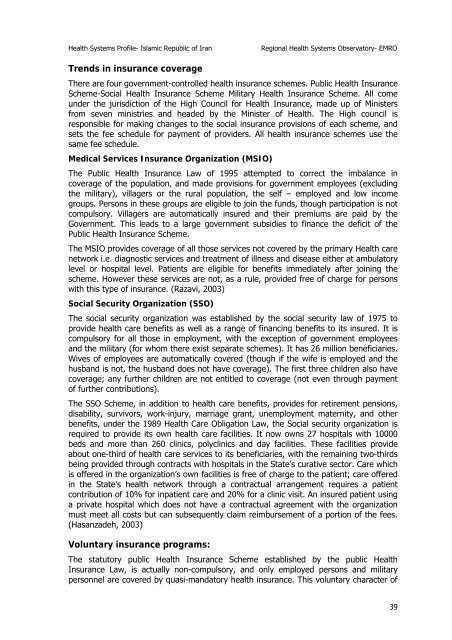Health system profile - Islamic Republic of Iran - What is GIS - World ...
Health system profile - Islamic Republic of Iran - What is GIS - World ...
Health system profile - Islamic Republic of Iran - What is GIS - World ...
Create successful ePaper yourself
Turn your PDF publications into a flip-book with our unique Google optimized e-Paper software.
<strong>Health</strong> Systems Pr<strong>of</strong>ile- <strong>Islamic</strong> <strong>Republic</strong> <strong>of</strong> <strong>Iran</strong> Regional <strong>Health</strong> Systems Observatory- EMRO<br />
Trends in insurance coverage<br />
There are four government-controlled health insurance schemes. Public <strong>Health</strong> Insurance<br />
Scheme-Social <strong>Health</strong> Insurance Scheme Military <strong>Health</strong> Insurance Scheme. All come<br />
under the jur<strong>is</strong>diction <strong>of</strong> the High Council for <strong>Health</strong> Insurance, made up <strong>of</strong> Min<strong>is</strong>ters<br />
from seven min<strong>is</strong>tries and headed by the Min<strong>is</strong>ter <strong>of</strong> <strong>Health</strong>. The High council <strong>is</strong><br />
responsible for making changes to the social insurance prov<strong>is</strong>ions <strong>of</strong> each scheme, and<br />
sets the fee schedule for payment <strong>of</strong> providers. All health insurance schemes use the<br />
same fee schedule.<br />
Medical Services Insurance Organization (MSIO)<br />
The Public <strong>Health</strong> Insurance Law <strong>of</strong> 1995 attempted to correct the imbalance in<br />
coverage <strong>of</strong> the population, and made prov<strong>is</strong>ions for government employees (excluding<br />
the military), villagers or the rural population, the self – employed and low income<br />
groups. Persons in these groups are eligible to join the funds, though participation <strong>is</strong> not<br />
compulsory. Villagers are automatically insured and their premiums are paid by the<br />
Government. Th<strong>is</strong> leads to a large government subsidies to finance the deficit <strong>of</strong> the<br />
Public <strong>Health</strong> Insurance Scheme.<br />
The MSIO provides coverage <strong>of</strong> all those services not covered by the primary <strong>Health</strong> care<br />
network i.e. diagnostic services and treatment <strong>of</strong> illness and d<strong>is</strong>ease either at ambulatory<br />
level or hospital level. Patients are eligible for benefits immediately after joining the<br />
scheme. However these services are not, as a rule, provided free <strong>of</strong> charge for persons<br />
with th<strong>is</strong> type <strong>of</strong> insurance. (Razavi, 2003)<br />
Social Security Organization (SSO)<br />
The social security organization was establ<strong>is</strong>hed by the social security law <strong>of</strong> 1975 to<br />
provide health care benefits as well as a range <strong>of</strong> financing benefits to its insured. It <strong>is</strong><br />
compulsory for all those in employment, with the exception <strong>of</strong> government employees<br />
and the military (for whom there ex<strong>is</strong>t separate schemes). It has 26 million beneficiaries.<br />
Wives <strong>of</strong> employees are automatically covered (though if the wife <strong>is</strong> employed and the<br />
husband <strong>is</strong> not, the husband does not have coverage). The first three children also have<br />
coverage; any further children are not entitled to coverage (not even through payment<br />
<strong>of</strong> further contributions).<br />
The SSO Scheme, in addition to health care benefits, provides for retirement pensions,<br />
d<strong>is</strong>ability, survivors, work-injury, marriage grant, unemployment maternity, and other<br />
benefits, under the 1989 <strong>Health</strong> Care Obligation Law, the Social security organization <strong>is</strong><br />
required to provide its own health care facilities. It now owns 27 hospitals with 10000<br />
beds and more than 260 clinics, polyclinics and day facilities. These facilities provide<br />
about one-third <strong>of</strong> health care services to its beneficiaries, with the remaining two-thirds<br />
being provided through contracts with hospitals in the State's curative sector. Care which<br />
<strong>is</strong> <strong>of</strong>fered in the organization’s own facilities <strong>is</strong> free <strong>of</strong> charge to the patient; care <strong>of</strong>fered<br />
in the State's health network through a contractual arrangement requires a patient<br />
contribution <strong>of</strong> 10% for inpatient care and 20% for a clinic v<strong>is</strong>it. An insured patient using<br />
a private hospital which does not have a contractual agreement with the organization<br />
must meet all costs but can subsequently claim reimbursement <strong>of</strong> a portion <strong>of</strong> the fees.<br />
(Hasanzadeh, 2003)<br />
Voluntary insurance programs:<br />
The statutory public <strong>Health</strong> Insurance Scheme establ<strong>is</strong>hed by the public <strong>Health</strong><br />
Insurance Law, <strong>is</strong> actually non-compulsory, and only employed persons and military<br />
personnel are covered by quasi-mandatory health insurance. Th<strong>is</strong> voluntary character <strong>of</strong><br />
39

















